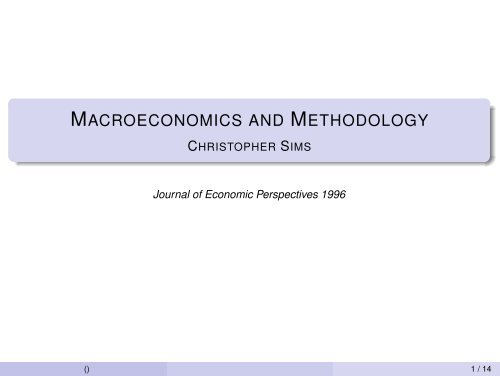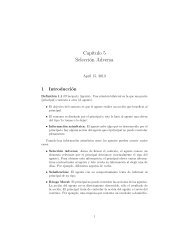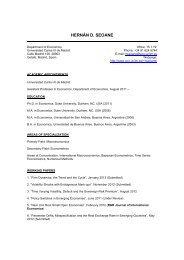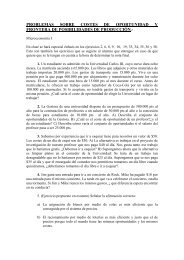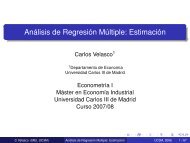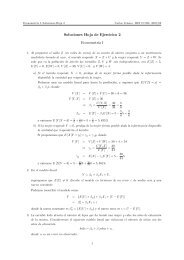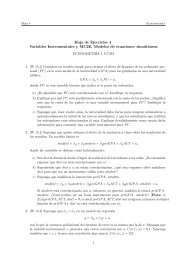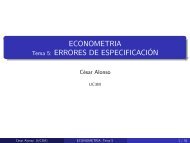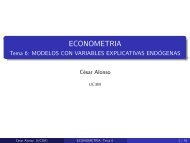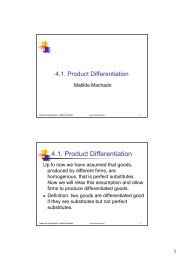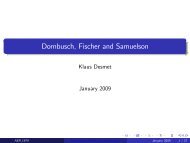Macroeconomics and Methodology Christopher Sims
Macroeconomics and Methodology Christopher Sims
Macroeconomics and Methodology Christopher Sims
Create successful ePaper yourself
Turn your PDF publications into a flip-book with our unique Google optimized e-Paper software.
MACROECONOMICS AND METHODOLOGY<br />
CHRISTOPHER SIMS<br />
Journal of Economic Perspectives 1996<br />
() 1 / 14
Outline<br />
Advances in sciences: discuss the view of science as data reduction<br />
Evaluation of theories⇒ science-as-data-reduction view vs hypothesis<br />
testing view<br />
The role of statistical inference across disciplines<br />
Rhetoric of economics<br />
Real Business Cycle School<br />
Progress in Quantitative <strong>Macroeconomics</strong><br />
() 2 / 14
Science as data reduction<br />
Advances in natural sciences are discoveries of ways to compress<br />
data with minimal loss of information.<br />
Example: Tycho Brahe accumulated large amounts of reliable data on the movements of<br />
the planets. Kepler observed that they are all elliptical orbits with the sun at a focus.<br />
Economics: same aim but less successful ⇒ Whatever theory<br />
economist use to characterize data on the economy, the actual data<br />
contain substantial variation that is not captured in the theory.<br />
() 3 / 14
Critique to the hypothesis testing view<br />
Common view of economists: formulate testable hypothesis <strong>and</strong><br />
confront them with data.<br />
⇒ True hypothesis survive the test, false ones would be eliminated.<br />
Critique 1: Hypothesis testing view is dependent on the idea that there<br />
are true <strong>and</strong> false theories.<br />
⇒ The degree to which theories succeed in reducing data can be a continuum.<br />
⇒There are better theories than others. “Worse” theories are not necessarily false <strong>and</strong> do<br />
not have to be rejected.<br />
Critique 2: A naive hypothesis testing approach might accept a theory<br />
as “true” but the theory can be so complex that do not allow important<br />
data reduction.<br />
() 4 / 14
The role of statistical inference across disciplines<br />
Formal statistical inference is not important when:<br />
the data are so abundant that allow the available theories to be clearly<br />
ranked ⇒ Experimental natural sciences.<br />
there is no need to choose among competing - observationally<br />
equivalent- theories.<br />
() 5 / 14
The role of statistical inference across disciplines<br />
Economics:<br />
Then if:<br />
Little experimentation possible. Particularly true for macroeconomics.<br />
Exist competing theories - observationally equivalent- to some questions.<br />
Important policy questions dem<strong>and</strong> opinions from economic experts.<br />
If data do not make the choice of the theory obvious<br />
<strong>and</strong> predictions of policy effects depend on the choice of the theory<br />
⇒ experts can only discuss their conclusions only using notions of probability.<br />
() 6 / 14
The rhetoric of Economics<br />
Concern: Too much attention is given to the development of rhetorical<br />
devices in economic argument <strong>and</strong> to encourage rhetorical skill among<br />
economist. (McCloskey (1983) methodological essay).<br />
⇒ Many economist are willing to use arguments they know are flawed<br />
without explaining the flaws or cite evidence they know could be shown<br />
to be misleading, for sake of rhetorical effectiveness.<br />
Rhetoric should remain secondary.<br />
() 7 / 14
General equilibrium modeling<br />
<strong>Macroeconomics</strong> is a branch of economics that makes drastic<br />
simplifications for the sake of studying a phenomena (the business cycle,<br />
economic growth) that inherently requires analysis of general<br />
equilibrium.<br />
It is natural <strong>and</strong> promising that macroeconomists, as computational<br />
power exp<strong>and</strong>s, are exploring <strong>and</strong> using dynamic, stochastic, general<br />
equilibrium (DSGE) models.<br />
Still, the models are too stylized <strong>and</strong> too remote from fitting the data to<br />
provide reliable guide to policy.<br />
DSGE modeling has delivered little empirical payoff so far.<br />
() 8 / 14
Real Business Cycle School (Kydl<strong>and</strong> <strong>and</strong> Prescott)<br />
According to K&P:<br />
⇒ macroeconomists are said to have available a “well-tested” theory, or<br />
“st<strong>and</strong>ard” theory.<br />
⇒ They do computational “experiments”.<br />
⇒ These experiments usually results in “established theory becoming<br />
stronger” but occasionally discover an extension of the existing theory that is<br />
useful, <strong>and</strong> thereby “established theory” is “improved”.<br />
These analogies with established physical sciences are strained.<br />
() 9 / 14
Real Business Cycle School (Kydl<strong>and</strong> <strong>and</strong> Prescott)<br />
K&P say that the neoclassical stochastic growth model is a “well<br />
tested” theory but they do not discuss its limitations.<br />
⇒ Even within the researches using this theory there is no illusion that it<br />
is uncontroversial.<br />
RBC research has ignored most of the known facts about the<br />
business cycle in assessing the match between DSGE models <strong>and</strong> the<br />
facts<br />
⇒ K&P do not document the way theory does <strong>and</strong> does not match<br />
the data.<br />
We may still be interested in a poorly fitting theory if:<br />
⇒ it offers a dramatic data compression.<br />
⇒ it is a type of theory that promisses to fit better with further work.<br />
() 10 / 14
Real Business Cycle School (Kydl<strong>and</strong> <strong>and</strong> Prescott)<br />
What K&P call “computational experiments” are computations, not<br />
experiments.<br />
k&P argue that is reasonable to look at the theoretical probability<br />
distribution implied by a model for a set of statistics <strong>and</strong> to compare this<br />
to the statistics computed from actual data<br />
⇒ How to compare a distribution from the stochastic model to a<br />
statistic of the actual data? Little guidance.<br />
() 11 / 14
Real Business Cycle School (Kydl<strong>and</strong> <strong>and</strong> Prescott)<br />
K&P definition of what constitutes a well tested theory does not suffices<br />
when we need to consider which of two or more models/theories<br />
with different policy implications is more reliable.<br />
⇒ K&P argument: Neoclassical stochastic growth model constitutes a<br />
well tested theory because this framework produce “normal-looking<br />
fluctuations” or “similar to those actually observed”.<br />
⇒ When we have 2 or more models it is not convincing to say that we<br />
should be more confident in the one whose simulated data is more<br />
“normal-looking” ⇒ Need to engage in statistical inference.<br />
() 12 / 14
Real Business Cycle School (Kydl<strong>and</strong> <strong>and</strong> Prescott)<br />
K&P claim that “searching within some parametric class of economies<br />
for the one that best fits a set of aggregate time series makes litlle sense,<br />
because it isn’t likely to answer an interesting question”.<br />
It does make sense.<br />
Example:<br />
⇒ “How much of the US postwar economy would have fluctuated if technology shocks had<br />
been the only source of fluctuations?<br />
Approach:<br />
⇒ construct a parametric class of DSGE models in which the parameter indexed the<br />
contribution of technology shocks to fluctuations.<br />
⇒ Examine behavior of model fit as a function of this parameter.<br />
- The model fit is insensitive to the parameter (model weakely identified)<br />
or<br />
- Some sources of impulse response could be ruled out as unlikely, because they implied a<br />
poor fit.<br />
() 13 / 14
Progress in quantitative macroeconomics<br />
Streams of research:<br />
Work based on DSGE models using formal methods of probability-based<br />
inference:<br />
- McGrattan, Rogerson <strong>and</strong> Wright (1993): estimate a st<strong>and</strong>ard real<br />
bussiness cycle model using maximum likelihood.<br />
- Leeper <strong>and</strong> <strong>Sims</strong> (1994): RBC + fluctuating relative price of<br />
consumption <strong>and</strong> capital goods + monetary <strong>and</strong> fiscal sectors.<br />
Policy modeling in the tradition of simultaneous equations modeling.<br />
Work based on weakely identified time series models to isolate the<br />
effects of monetary policy.<br />
() 14 / 14


